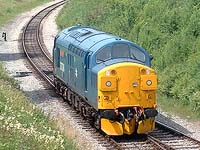|
17th
April 1999: "The Settle Excursioner", also a Pathfinder tour,
had 47558 from Banbury to Crewe, and return. 92001 from Crewe to
Carlisle (with 37152 and 37165 tucked inside), and the two 37's booked
to run in multiple from Carlisle to Crewe, via the Settle & Carlisle
line. But the multiple working failed to materialize, and 37165
was not able to provide any power. So 37152 had a 475 ton train, plus a
105 ton locomotive, to haul up to Ais Gill. It made a lot of noise in
the process, and passed Ais Gill summit at 25 mph. At Ribblehead, the
fault was rectified, and both locos provided power thereafter. [view log
of 37152 & 37165] |
|

